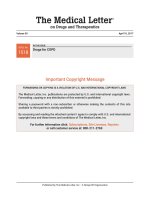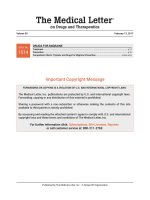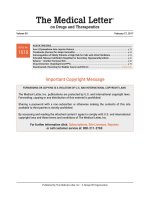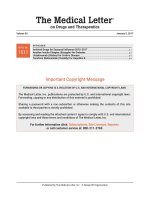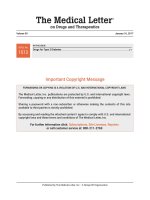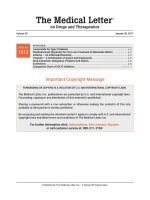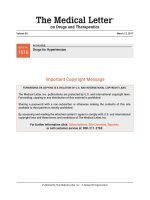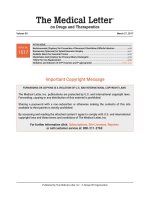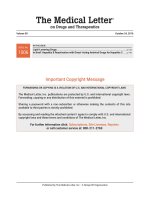The medical letter on drugs and therapeutics october 12 2015
Bạn đang xem bản rút gọn của tài liệu. Xem và tải ngay bản đầy đủ của tài liệu tại đây (244.14 KB, 9 trang )
The Medical Letter
®
on Drugs and Therapeutics
Objective Drug Reviews Since 1959
Volume 57
ISSUE
ISSUE
No.
1433
1479
Volume 56
October 12, 2015
IN THIS ISSUE
SGLT2 Inhibitors: New Reports ...........................................................................................p 139
Evolocumab (Repatha) – A Second PCSK9 Inhibitor to Lower LDL-Cholesterol ............. p 140
Daclatasvir (Daklinza) for HCV Genotype 3 Infection ........................................................p 142
Eloctate for Hemophilia A ....................................................................................................p 143
Addendum: PCV13 for Adults 65 Years and Older .............................................................p 144
Important Copyright Message
FORWARDING OR COPYING IS A VIOLATION OF U.S. AND INTERNATIONAL COPYRIGHT LAWS
The Medical Letter, Inc. publications are protected by U.S. and international copyright laws.
Forwarding, copying or any distribution of this material is prohibited.
Sharing a password with a non-subscriber or otherwise making the contents of this site
available to third parties is strictly prohibited.
By accessing and reading the attached content I agree to comply with U.S. and international
copyright laws and these terms and conditions of The Medical Letter, Inc.
For further information click: Subscriptions, Site Licenses, Reprints
or call customer service at: 800-211-2769
Published by The Medical Letter, Inc. • A Nonprofit Organization
Revised 11/10/2015: See p. 144
The Medical Letter publications are protected by US and international copyright laws.
Forwarding, copying or any other distribution of this material is strictly prohibited.
For further information call: 800-211-2769
The Medical Letter
®
on Drugs and Therapeutics
Objective Drug Reviews Since 1959
Volume 57
ISSUE
ISSUE No.
1433
1479
Volume 56
▶
October 12, 2015
Take CME Exams
ALSO IN THIS ISSUE
Evolocumab (Repatha) – A Second PCSK9 Inhibitor to Lower LDL-Cholesterol ............. p 140
Daclatasvir (Daklinza) for HCV Genotype 3 Infection ........................................................p 142
Eloctate for Hemophilia A ....................................................................................................p 143
Addendum: PCV13 for Adults 65 Years and Older .............................................................p 144
SGLT2 Inhibitors: New Reports
The recent report of a reduction in cardiovascular mortality
in patients with type 2 diabetes treated with the SGLT2
inhibitor empagliflozin (Jardiance) was published soon
after the FDA issued new warnings about an increased
risk of fractures with canagliflozin (Invokana).
SGLT2 INHIBITORS — SGLT2 (sodium-glucose
co-transporter 2), a membrane protein expressed
mainly in the kidney, transports filtered glucose from
the proximal renal tubule into tubular epithelial cells.
SGLT2 inhibitors decrease renal glucose reabsorption and increase urinary glucose excretion, resulting
in lower blood glucose levels that are independent of
insulin secretion and a modest reduction in HbA1c.
These drugs also increase urinary sodium excretion,
cause weight loss, and lower blood pressure.
View our detailed online table: SGLT-2 Inhibitors
Adverse Effects – SGLT2 inhibitors can cause genital
mycotic infections, urinary tract infections, increases
in serum creatinine and decreases in eGFR, and
increases in LDL cholesterol, and were recently
associated with euglycemic ketoacidosis.1,2
Table 1. Dosage and Cost of SGLT2 Inhibitors
Drug
Formulations
Usual
Dosage
Canagliflozin –
Invokana (Janssen)
100, 300 mg
tabs
100-300 mg
once/d
Cost1
$363.10
Dapagliflozin –
5, 10 mg
Farxiga (AstraZeneca) tabs
5-10 mg
once/d
342.90
Empagliflozin –
10, 25 mg
Jardiance (Boehringer tabs
Ingelheim/Lilly)
10-25 mg
once/d
342.80
1. Approximate WAC for 30 days’ treatment at the lowest usual dosage.
WAC = wholesaler acquisition cost or manufacturer’s published price to
wholesalers; WAC represents a published catalogue or list price and may
not represent an actual transactional price. Source: AnalySource® Monthly. September 5, 2015. Reprinted with permission by First Databank, Inc. All
rights reserved. ©2015. www.fdbhealth.com/policies/drug-pricing-policy.
CARDIOVASCULAR OUTCOMES — In a randomized,
double-blind trial, 7020 patients with type 2 diabetes
and established cardiovascular disease (prior
myocardial infarction or stroke or angiographically
demonstrated obstruction) took empagliflozin 10 or
25 mg/day or placebo for a median of 2.6 years. The
primary endpoint was a composite of cardiovascular
death, nonfatal myocardial infarction, or nonfatal
stroke. There were no significant differences between
patients taking either dose of empagliflozin and those
receiving placebo in the incidence of myocardial
infarction or stroke, but patients taking the active drug
had a significantly lower incidence of cardiovascular
death (3.7% vs 5.9%, HR 0.62). Treatment with
empagliflozin was also associated with significant
reductions in hospitalization for heart failure (2.7% vs
4.1%) and death from any cause (5.7% vs 8.3%). There
was no difference in the incidence of fractures.3
FRACTURE RISK — In an unpublished, double-blind
trial conducted as part of an FDA postmarketing
requirement, 714 patients 55-80 years old with poorly
controlled type 2 diabetes were randomized to canagliflozin 100 or 300 mg/day or placebo. At 2 years,
those receiving canagliflozin 100 and 300 mg had
placebo-corrected decreases in bone mineral density
at the total hip of 0.9% and 1.2%, respectively, and smaller decreases at the lumbar spine, the femoral neck, and
(with the 300-mg dose) the distal forearm. An FDA
analysis of fractures occurring in 9 clinical trials with
a mean exposure to canagliflozin of 85 weeks found
incidence rates of 1.4 and 1.5 per 100 patient-years
with 100 and 300 mg/day of canagliflozin, respectively,
compared to 1.1 with placebo or an active comparator.4 An increased incidence of fractures was reported
previously in patients with moderate renal impairment
taking dapagliflozin (Farxiga), and there appears to be a
theoretical rationale (increased phosphate, parathyroid
hormone levels) for an adverse class effect on bone.5
139
Published by The Medical Letter, Inc. • A Nonprofit Organization
The Medical Letter
Vol. 57 (1479)
®
CONCLUSION — A significant decrease in
cardiovascular mortality has been reported with use of
the SGLT2 inhibitor empagliflozin (Jardiance) to treat
patients with type 2 diabetes who have established
cardiovascular disease. The mechanism of this
reduction is unclear, and these results may not apply
to patients with type 2 diabetes and less advanced
cardiovascular disease. Whether the increase in
fractures reported with canagliflozin (Invokana)
could also occur with empagliflozin remains to be
established. All SGLT2 inhibitors are only modestly
effective for treatment of diabetes. ■
▶
Evolocumab (Repatha) – A Second
PCSK9 Inhibitor to Lower LDLCholesterol
Evolocumab (Repatha – Amgen), a subcutaneously
injected PCSK9 inhibitor, has been approved by the
FDA as an adjunct to diet and maximally tolerated
statin therapy for adults with heterozygous familial
hypercholesterolemia (HeFH) or clinical atherosclerotic
cardiovascular disease who require additional
lowering of LDL-cholesterol (LDL-C). It was also
approved as an adjunct to diet and other LDL-lowering
therapies in patients with homozygous familial
hypercholesterolemia (HoFH) who require additional
lowering of LDL-C. Evolocumab is the second PCSK9
inhibitor to be approved in the US; alirocumab (Praluent)
was approved earlier.1
Pronunciation Key
Evolocumab: e” voe lok’ ue mab
Repatha: ri pa’ tha
MECHANISM OF ACTION — PCSK9 (proprotein
convertase subtilisin kexin type 9) binding to
LDL receptors on hepatocytes promotes receptor
degradation, prevents LDL-C clearance from blood,
and increases serum concentrations of LDL-C.
Evolocumab is a human IgG2 monoclonal antibody
that targets PCSK9, prevents it from binding to LDL
receptors, and increases hepatic uptake of LDL-C.
October 12, 2015
1. In brief: ketoacidosis with SGLT2 inhibitors. Med Lett Drugs
Ther 2015; 57:94.
2. AL Peters et al. Euglycemic diabetic ketoacidosis: a potential
complication of treatment with sodium-glucose cotransporter
2 inhibition. Diabetes Care 2015; 38:1687.
3. B Zinman et al. Empagliflozin, cardiovascular outcomes, and
mortality in type 2 diabetes. N Engl J Med 2015 Sept 17 (epub).
4. FDA Drug Safety Communication: FDA revises label of diabetes
drug canagliflozin (Invokana, Invokamet) to include updates
on bone fracture risk and new information on decreased bone
mineral density. Available at: www.fda.gov/Drugs/DrugSafety/
ucm461449.htm. Accessed October 1, 2015.
5. SI Taylor et al. Possible adverse effects of SGLT2 inhibitors on
bone. Lancet Diabetes Endocrinol 2015; 3:8.
Table 1. Pharmacology
Class
Formulation
Route
Tmax
Metabolism
Elimination
Half-life
PCSK9 inhibitor
140 mg/mL preservative-free solution in
single-use prefilled syringe or autoinjector
Subcutaneous injection
3-4 days
Probably degradation to small peptides and
amino acids
Low concentrations: primarily saturable binding
to PCSK9
Higher concentrations: primarily nonsaturable
proteolysis
11-17 days
CLINICAL STUDIES — Results of some clinical trials of
evolocumab are summarized in Table 3.2-6
A prespecified exploratory analysis of the OSLER-1
and -2 trials found that after one year, the KaplanMeier estimated percentages of patients having a
cardiovascular event were significantly lower among
those receiving evolocumab than those receiving
standard treatment alone (0.95% vs 2.18%).2 A more
definitive study to evaluate the effect of evolocumab
on cardiovascular outcomes (FOURIER) is underway.
ADVERSE EFFECTS — The most common adverse
effects reported in clinical trials with evolocumab
included nasopharyngitis, upper respiratory tract
infection, influenza, back pain, and injection-site
reactions.
Table 2. PCSK9 Inhibitors for Hypercholesterolemia
Drug
Formulations
Usual Adult Dosage
Cost1
Alirocumab – Praluent (Sanofi/Regeneron)
75, 150 mg/mL single-use pens,
prefilled syringes
Initial: 75 mg SC q2 wks
Max: 150 mg SC q2 wks
$13,440.00
Evolocumab – Repatha (Amgen)
140 mg/mL single-use autoinjectors,
prefilled syringes
Initial: 140 mg SC q2 wks or
420 mg SC once/month2
Max: 140 mg SC q2 wks or
420 mg SC once/month2
1.
2.
140
13,015.40
Approximate WAC for one year’s treatment at the lowest initial dose. WAC = wholesaler acquisition cost or manufacturer’s published price to wholesalers;
WAC represents a published catalogue or list price and may not represent an actual transactional price. Source: AnalySource® Monthly. September 5, 2015.
Reprinted with permission by First Databank, Inc. All rights reserved. ©2015. www.fdbhealth.com/policies/drug-pricing-policy.
Dosage for patients with heterozygous familial hypercholesterolemia (HeFH) or atherosclerotic CVD. Dosage for patients with homozygous familial hypercholesterolemia (HoFH) is 420 mg SC once monthly.
The Medical Letter
®
Vol. 57 (1479)
October 12, 2015
Table 3. Some Evolocumab Clinical Trials
Mean LDL-C Change
(placebo-corrected)
Trial
Population
Treatment Arms
OSLER-1 and -21
(n=4465)
52 weeks
Patients with various degrees of
high LDL-C
Evolocumab 140 mg q2 wks2
Evolocumab 420 mg q4 wks2
Standard treatment alone3
-60.9%4
DESCARTES5
(n= 901)
52 weeks
MENDEL-26
(n=614)
12 weeks
LDL-C ≥75 mg/dL with diet alone,
diet plus statin therapy, or statin
therapy with or without ezetimibe
Low CV risk patients with
LDL-C ≥100 and <190 mg/dL
receiving no background therapy
Evolocumab 420 mg q4 wks
Placebo
-57.0%
-57.1%
-54.8%
-17.9%7
RUTHERFORD-28
(n=331)
12 weeks
TESLA Part B9
(n=49)
12 weeks
HeFH on stable lipid-lowering
therapy
Evolocumab 140 mg q2 wks
Evolocumab 420 mg q4 wks
Ezetimibe once/d
Placebo
Evolocumab 140 mg q2 wks
Evolocumab 420 mg q4 wks
Placebo
Evolocumab 420 mg q4 wks
Placebo
HoFH on stable lipid-lowering therapy
-59.2%
-61.3%
-30.9%
CV = cardiovascular; HeFH = heterozygous familial hypercholesterolemia; HoFH = homozygous familial hypercholesterolemia
1. MS Sabatine et al. N Engl J Med 2015; 372:1500.
2. In addition to standard treatment.
3. Standard treatment was based on local guidelines for treatment of LDL-C.
4. LDL-C change at 12 weeks for both doses of evolocumab relative to standard of care alone.
5. DJ Blom et al. N Engl J Med 2014; 370:1809.
6. MJ Koren et al. J Am Coll Cardiol 2014; 63:2531.
7. Mean LDL-C change for patients also receiving biweekly and once monthly placebo injections, respectively.
8. FJ Raal et al. Lancet 2015; 385:331.
9. FJ Raal et al. Lancet 2015; 385:341.
A meta-analysis of 12 randomized, controlled trials
found that there were no significant differences in
adverse events between evolocumab, ezetimibe, and
placebo.7 Neurocognitive events were reported in <1%
of patients receiving evolocumab, but more often than
in those receiving placebo.
PREGNANCY — Evolocumab has not been studied in
pregnant women. Monoclonal antibodies are unlikely
to cross the placenta in the first trimester, but may
do so subsequently. Animal studies found that
evolocumab had no adverse effects on the fetus.
DOSAGE AND ADMINISTRATION — The recommended
starting dosage of evolocumab is 140 mg injected
subcutaneously once every 2 weeks or 420 mg (three
140-mg injections within 30 minutes) once monthly
in patients with HeFH or clinical atherosclerotic
cardiovascular disease, or 420 mg once monthly in
patients with HoFH. The drug should be injected into
the abdomen, thigh, or upper arm; the injection site
should be rotated with each use. If a dose is missed,
it should be administered only if the next dose is
scheduled to be given at least 7 days later. LDL-C
levels should be measured 4-8 weeks after starting
evolocumab in patients with HoFH.
Evolocumab should be stored in the refrigerator,
and warmed to room temperature for at least 30
minutes before injection. It can also be stored at room
temperature, but must be used within 30 days.
CONCLUSION — The second FDA-approved PCSK9
inhibitor evolocumab (Repatha) appears to be similar
in efficacy and safety to alirocumab (Praluent),
but no comparative studies are available. Given by
subcutaneous injection every 2 weeks or once monthly,
evolocumab can further lower LDL-cholesterol levels
by about 60% in patients at high risk for atherosclerotic
cardiovascular disease already taking maximal statin
therapy. Its effect on cardiovascular outcomes remains
to be established. The long-term efficacy and safety
of both evolocumab and alirocumab are unknown, and
they are expensive. ■
1. Alirocumab (Praluent) to lower LDL-cholesterol. Med Lett
Drugs Ther 2015; 57:113.
2. MS Sabatine et al. Efficacy and safety of evolocumab in reducing lipids and cardiovascular events. N Engl J Med 2015;
372:1500.
3. DJ Blom et al. A 52-week placebo-controlled trial of evolocumab in hyperlipidemia. N Engl J Med 2014; 370:1809.
4. FJ Raal et al. PCSK9 inhibition with evolocumab (AMG 145)
in heterozygous familial hypercholesterolaemia (RUTHERFORD-2): a randomised, double-blind, placebo-controlled trial.
Lancet 2015; 385:331.
5. MJ Koren et al. Anti-PCSK9 monotherapy for hypercholesterolemia: the MENDEL-2 randomized, controlled phase III clinical
trial of evolocumab. J Am Coll Cardiol 2014; 63:2531.
6. FJ Raal et al. Inhibition of PCSK9 with evolocumab in homozygous familial hypercholesterolaemia (TESLA Part B): a randomised, double-blind, placebo-controlled trial. Lancet 2015;
385:341.
7. XL Zhang et al. Safety and efficacy of anti-PCSK9 antibodies:
a meta-analysis of 25 randomized, controlled trials. BMC Med
2015; 13:123.
141
The Medical Letter
▶
®
Daclatasvir (Daklinza) for HCV
Genotype 3 Infection
The FDA has approved daclatasvir (Daklinza – BMS),
an oral direct-acting antiviral drug, for use with
sofosbuvir (Sovaldi)1 for treatment of chronic hepatitis
C virus (HCV) genotype 3 infection. Daclatasvir is
the first drug approved for this indication that does
not require the addition of interferon or ribavirin. It is
approved in Japan and Europe in combination with
other drugs for treatment of HCV genotypes 1-4.
Pronunciation Key
Daclatasvir : da kla’ tas veer
Daklinza: da klin’ za
GENOTYPE 3 — HCV genotype 3 is responsible for <10%
of HCV cases in the US. It is the predominant genotype
in South Asian countries such as India and Pakistan
and is responsible for >25% of HCV cases in Central
Asia, Australasia, eastern Europe, and tropical Latin
America.2 It has been associated with higher rates of
steatosis, cirrhosis, and hepatocellular carcinoma than
other HCV genotypes.3,4
STANDARD TREATMENT — Treatment options for HCV
genotype 3 infection are limited.5 In an open-label
trial in 544 patients with HCV genotype 3 infection,
sofosbuvir plus ribavirin produced a sustained
virologic response 12 weeks after stopping treatment
(SVR12) in 71% and 84% of patients treated for 16
weeks and 24 weeks, respectively. The SVR12 rate in
patients treated with sofosbuvir, peginterferon, and
ribavirin for 12 weeks was 93%.6 Prior to the approval
of sofosbuvir, patients with HCV genotype 3 infection
were typically treated with 24 weeks of peginterferon
and ribavirin.
MECHANISM OF ACTION — Daclatasvir inhibits viral
replication by binding to the N-terminus of NS5A, an
HCV protein. Sofosbuvir inhibits the HCV NS5B RNAdependent RNA polymerase, which is also essential
for viral replication.
Table 1. Pharmacology
Class
Formulation
Route
Metabolism
Elimination
Half-life (terminal)
HCV NS5A inhibitor
30, 60 mg tablets
Oral
Primarily hepatic by CYP3A4
Feces (88%); urine (7%)
12-15 hours
A CLINICAL STUDY — Approval of daclatasvir
was based on an open-label trial (ALLY-3) in 101
treatment-naive patients and 51 previously treated
patients with HCV genotype 3 infection. All patients
142
Vol. 57 (1479)
October 12, 2015
received daclatasvir 60 mg and sofosbuvir 400 mg
once daily for 12 weeks. SVR12, the primary endpoint,
was achieved in 90% of treatment-naive patients and
in 86% of previously treated patients. SVR12 rates
were lower in patients with cirrhosis than in those
without (63% vs 96%).7
ADVERSE EFFECTS — The most common treatmentrelated adverse effects reported in the ALLY-3 trial
were headache (14%), fatigue (14%), and nausea (8%).
PREGNANCY AND LACTATION — Daclatasvir produced
embryofetal adverse effects at doses 33 and 98 times
the recommended human dose in pregnant rats and
rabbits, respectively. The drug has not been studied in
pregnant women. Daclatasvir has been detected in the
milk of lactating rats.
DRUG INTERACTIONS — Severe, symptomatic bradycardia has occurred when the antiarrhythmic drug
amiodarone (Cordarone, and others) was administered
with sofosbuvir and daclatasvir8; concomitant use of
these drugs is not recommended. In patients with no
treatment alternative, inpatient cardiac monitoring is
recommended for the first 48 hours after treatment
is initiated, followed by daily heart rate monitoring,
either at home or in an outpatient setting, for at least
the first 2 weeks of treatment.
Daclatasvir is a substrate of CYP3A. Plasma concentrations of the drug were reduced when it was
taken with efavirenz (Sustiva), a moderate CYP3A4
inducer. Concurrent use of daclatasvir with a strong
CYP3A4 inducer, such as rifampin (Rifadin, and
generics), is contraindicated. Coadministration of a
moderate or strong CYP3A4 inhibitor can increase
plasma concentrations of daclatasvir.9
Daclatasvir is an inhibitor of P-glycoprotein (P-gp),
organic anion transporting polypeptide (OATP) 1B1,
OATP1B3, and breast cancer resistance protein (BCRP).
Coadministration of daclatasvir with drugs that are
substrates of any of these transporters, such as digoxin
(Lanoxin, and others), the anticoagulant dabigatran
(Pradaxa), or statins such as rosuvastatin (Crestor), can
increase serum concentrations of these drugs.
DOSAGE, ADMINISTRATION, AND COST — The
recommended dosage of daclatasvir is 60 mg taken
once daily with sofosbuvir 400 mg for 12 weeks.
In patients with cirrhosis, current guidelines
recommend 24 weeks of treatment with or without
ribavirin.4 The daily dose of daclatasvir should be
increased to 90 mg if taken with a moderate CYP3A4
inducer and reduced to 30 mg if taken with a strong
The Medical Letter
®
CYP3A4 inhibitor. The cost of 12 weeks’ treatment
with daclatasvir and sofosbuvir is $147,000.10
CONCLUSION — Daclatasvir (Daklinza) plus sofosbuvir
(Sovaldi) is the first all-oral, interferon- and ribavirinfree drug regimen for treatment of hepatitis C virus
genotype 3 infection. This combination is effective
and convenient, but it is very expensive. ■
1. Sofosbuvir (Sovaldi) for chronic hepatitis C. Med Lett Drugs
Ther 2014; 56:5.
2. JP Messina et al. Global distribution and prevalence of hepatitis
C virus genotypes. Hepatology 2015; 61:77.
3. J Ampuero et al. Review article: HCV genotype 3 – the new
treatment challenge. Aliment Pharmacol Ther 2014; 39:686.
4. F Kanwal et al. HCV genotype 3 is associated with an increased
risk of cirrhosis and hepatocellular cancer in a national sample
of U.S. Veterans with HCV. Hepatology 2014; 60:98.
5. American Association for the Study of Liver Diseases/Infectious Diseases Society of America/International Antiviral Society–USA. HCV Guidance: Recommendations for testing, managing, and treating hepatitis C. Available at www.hcvguidelines.
org. Accessed October 1, 2015.
6. GR Foster et al. Efficacy of sofosbuvir plus ribavirin with or
without peginterferon-alfa in patients with HCV genotype 3 infection and treatment-experienced patients with cirrhosis and
HCV genotype 2 infection. Gastroenterology 2015 Aug 3 (epub).
7. DR Nelson et al. All-oral 12-week treatment with daclatasvir
plus sofosbuvir in patients with hepatitis C virus genotype 3 infection: ALLY-3 phase III study. Hepatology 2015; 61:1127.
8. In brief: severe bradycardia with sofosbuvir and amiodarone.
Med Lett Drugs Ther 2015; 57:58.
9. Inhibitors and inducers of CYP enzymes and P-glycoprotein.
Med Lett Drugs Ther 2013; 55:e44.
10. Approximate WAC for 12 weeks’ treatment. WAC = wholesaler
acquisition cost, or manufacturer’s published price to wholesalers; WAC represents published catalogue or list prices and
may not represent actual transactional prices. Source: AnalySource® Monthly. September 5, 2015. Reprinted with permission by First Databank, Inc. All rights reserved. ©2015. www.
fdbhealth.com/policies/drugpricing-policy.
▶
Eloctate for Hemophilia A
The FDA has approved Eloctate (Biogen), a recombinant
factor VIII Fc fusion protein with an extended halflife, for use in adults and children with hemophilia
A. Eloctate is indicated for control and prevention of
bleeding episodes, perioperative management, and
routine prophylaxis to prevent or reduce the frequency
of bleeding episodes. It is the first antihemophilic factor
VIII Fc fusion protein to be approved for hemophilia A.
Pronunciation Key
Eloctate: el" ok' tate
FACTOR VIII REPLACEMENT THERAPY — Regular
injections of plasma-derived or recombinant factor
VIII products are the standard of care for prevention
of bleeding and joint destruction in patients with
Vol. 57 (1479)
October 12, 2015
hemophilia A. Plasma-derived products have been
associated with transmission of blood-borne viruses
such as HIV, hepatitis B, and hepatitis C, but use of
viral inactivation methods has eliminated most of
this risk. Plasma-derived and recombinant factor
VIII products are equally effective, but recombinant
products are more expensive.1 Previously available
factor VIII products have half-lives of about 12 hours
and must be administered 3-4 times per week to
maintain protective levels.
THE NEW PRODUCT — Eloctate consists of a
B-domain deleted analog of human coagulation factor
VIII covalently linked to the Fc domain of human IgG1.
Binding of the Fc domain to the FcRn receptor prolongs
its half-life by delaying lysosomal degradation and by
recycling the protein back into the circulation.2
A CLINICAL STUDY — FDA approval of Eloctate
was based on the results of an open-label, partially
randomized trial in 165 previously treated males ≥12
years old with severe hemophilia A. Patients received
either individualized prophylaxis (25-65 IU/kg every
3-5 days), fixed weekly prophylaxis (65 IU/kg), or ondemand treatment for bleeding episodes (10-50 IU/kg)
for a median of 28-32 weeks.3
Annualized bleeding rates per patient were significantly lower with individualized or fixed weekly
prophylaxis compared to on-demand treatment (1.6
and 3.6, respectively, vs 33.6). In patients receiving
individualized prophylaxis, the median dosing interval
was 3.5 days over the last 3 months of the study,
and 30% of those treated for ≥6 months achieved a
dosing interval of at least 5 days in the last 3 months.
A total of 757 bleeding episodes were reported in
106 patients, 98% of which were controlled with ≤2
IV injections of Eloctate. No bleeding episodes were
reported in 45.3% of patients receiving individualized
prophylaxis and in 17.4% of those receiving weekly
prophylaxis. All patients receiving on-demand treatment experienced bleeding episodes.3
ADVERSE EFFECTS — Hypersensitivity reactions
can occur with use of Eloctate. Patients should be
monitored for formation of neutralizing antibodies
(inhibitors) to factor VIII, a severe treatment-related
complication that occurs in up to 25-35% of previously
untreated patients with severe hemophilia A, but less
often in previously treated patients, and can lead to
lower-than-expected factor VIII levels and loss of
bleeding control.4 No patients receiving Eloctate in
the clinical trial developed inhibitors, but switching
previously treated patients to a new factor VIII
143
Revised 11/10/2015: In the table, Nuwiq's indications, half-life, and cost have been revised.
The Medical Letter
October 12, 2015
Vol. 57 (1479)
®
Table 1. Some Factor VIII Products for Hemophilia A
Product
Description
FDA-Approved Indications1
Half-Life2
Cost3
Advate
(Baxter)
Recombinant factor VIII (produced in
Chinese hamster ovary cell line)
▶ Control and prevention of bleeding episodes
▶ Perioperative management
▶ Routine prophylaxis to prevent or reduce
12 hrs
$4470.00
Eloctate
(Biogen)
Recombinant factor VIII Fc fusion protein
(produced in human embryonic kidney
cell line)
▶ Control and prevention of bleeding episodes
▶ Perioperative management
▶ Routine prophylaxis to prevent or reduce
19.7 hrs
Kogenote FS
(Baxter)
Recombinant factor VIII (produced in
hamster kidney cell line)
▶ Control and prevention of bleeding episodes
▶ Perioperative management
▶ Routine prophylaxis to prevent or reduce fre-
14-15 hrs
4380.00
(previously
treated patients)
frequency of bleeding episodes
5940.00
frequency of bleeding episodes
quency of bleeding episodes
▶ Reduction of joint damage risk in children
without prior damage
Nuwiq
(Octapharma)
Recombinant human factor VIII (produced
in human embryonic kidney cell line)
▶ Control and prevention of bleeding episodes
▶ Perioperative management
▶ Routine prophylaxis to prevent or reduce
17.1 hrs
(previously
treated adults)
5070.00
Recombinant factor VIII (produced in
Chinese hamster ovary cell line)
▶ Control and prevention of bleeding episodes
▶ Perioperative management
11-12 hrs4
4560.00
(previously
treated patients)
frequency of bleeding episodes
Xyntha
(Pfizer)
1. FDA-approved for use in children and adults.
2. In adults. The half-lives in children are shorter.
3. Approximate WAC for a single 50 IU/kg dose for a 60-kg patient for control and prevention of bleeding episodes. WAC = wholesaler acquisition cost or manufacturer’s published price to wholesalers; WAC represents a published catalogue or list price and may not represent an actual transactional price. Source:
AnalySource® Monthly. September 5, 2015. Reprinted with permission by First Databank, Inc. All rights reserved. ©2015. www.fdbhealth.com/policies/drugpricing-policy.
4. The pre-surgery half-life is 16.7 hrs.
concentrate has rarely been associated with inhibitor
development.1 A trial in previously untreated patients
is underway.
DOSAGE AND ADMINISTRATION — Eloctate is available
as a lyophilized powder in single-use vials containing
250, 500, 750, 1000, 1500, 2000, or 3000 IU of factor VIII
potency. The recommended starting dosage for routine
prophylaxis is 50 IU/kg IV every 4 days. The regimen
may be adjusted according to patient response (within
the range of 25-65 IU/kg) at 3-5 day intervals. Children
<6 years old may require more frequent or higher doses
(up to 80 IU/kg). Specific dosing recommendations for
control and prevention of bleeding episodes and during
surgery are included in the package insert.
CONCLUSION — Eloctate, a recombinant factor VIII Fc
fusion protein with an extended half-life, was effective
in preventing and controlling bleeding in patients with
severe hemophilia A. Compared to other currently
available factor VIII products, Eloctate's extended halflife reduces the number of doses required for routine
prophylaxis, which could improve adherence. Eloctate
has not been associated with formation of neutralizing
antibodies, but it was not studied in previously untreated
patients with severe hemophilia A, who have a higher
risk of this complication. Like other recombinant factor
VIII products, Eloctate is very expensive. ■
144
1. A Srivastava et al. Guidelines for the management of hemophilia. Haemophilia 2013; 19:e1.
2. ME Mancuso and PM Mannucci. Fc-fusion technology
and recombinant FVIII and VIX in the management of the
hemophilias. Drug Des Devel Ther 2014; 8:365.
3. J Mahlangu et al. Phase 3 study of recombinant factor VIII Fc
fusion protein in severe hemophilia A. Blood 2014; 123:317.
4. PM Mannucci et al. How we choose factor VIII to treat hemophilia. Blood 2012; 119:4108.
Addendum: PCV13 for Adults 65 Years and Older
(Med Lett Drugs Ther 2014; 56:102)
In 2014, the US Advisory Committee on Immunization
Practices (ACIP) recommended that all adults 65 years
old and older being vaccinated against pneumococcus for
the first time receive the pneumococcal conjugate vaccine
(PCV13) followed 6 to 12 months later by the pneumococcal
polysaccharide vaccine (PPSV23). In June 2015, the ACIP
changed the recommended interval between the two
vaccines to >1 year for immunocompetent adults ≥65
years old (MMWR Morbid Mortal Wkly Rep 2015; 674:944).
Separating the vaccines by a year or more may improve
the immune response to the serotypes in both vaccines. If
a dose of PPSV23 is given earlier than the recommended
interval, it does not need to be repeated.
Follow us on Twitter
Like us on Facebook
The Medical Letter
®
Continuing Medical Education Program
medicalletter.org/cme-program
Earn Up To 52 Credits Per Year
Choose CME from The Medical Letter in the format that’s right for you!
▶ Comprehensive Exam – Available online or in print to Medical Letter subscribers, this 130 question exam enables you to earn 26 credits immediately
upon successful completion of the test. A score of 70% or greater is required to pass the exam. Our comprehensive exams allow you to test at your
own pace in the comfort of your home or office. Comprehensive exams are offered every January and July enabling you to earn up to 52 credits per
year. $49/exam.
▶ Free Individual Exams – Free to active subscribers of The Medical Letter. Answer 10 questions per issue and submit answers online. Earn 2 credits/exam.
A score of 70% or greater is required to pass the exam.
▶ Paid Individual Exams – Available to non-subscribers. Answer 10 questions per issue and submit answers online. Earn 2 credits/exam. $12/exam.
A score of 70% or greater is required to pass the exam.
ACCREDITATION INFORMATION:
ACCME: The Medical Letter is accredited by the Accreditation Council for Continuing Medical Education to provide continuing medical education for physicians. The Medical
Letter designates this enduring material for a maximum of 2 AMA PRA Category 1 Credit(s)™. Physicians should claim only the credit commensurate with the extent of their
participation in the activity. This CME activity was planned and produced in accordance with the ACCME Essentials and Policies.
AAFP : This enduring material activity, The Medical Letter Continuing Medical Education Program, has been reviewed and is acceptable for up to 52 Prescribed credits by the
American Academy of Family Physicians. Term of approval begins January 1, 2015. Term of approval is for one year from this date. Each issue is approved for 2 Prescribed
credits. Credit may be claimed for one year from the date of each issue. Physicians should claim only the credit commensurate with the extent of their participation in the
activity.
ACPE: The Medical Letter is accredited by the Accreditation Council for Pharmacy Education as a provider of continuing pharmacy education. This exam is acceptable
for 2.0 hour(s) of knowledge-based continuing education credit (0.2 CEU).
The American Academy of Nurse Practitioners (AANP) and the American Academy of Physician Assistants (AAPA) accept AMA Category 1 credit for the Physician’s
Recognition Award from organizations accredited by the ACCME.
This activity, being ACCME (AMA) approved, is acceptable for Category 2-B credit by the American Osteopathic Association (AOA).
Physician Assistants: The National Commission on Certification of Physician Assistants (NCCPA) accepts AMA PRA Category 1 Credit(s)™ from organizations accredited by
ACCME. NCCPA also accepts AAFP Prescribed credits for recertification. The Medical Letter is accredited by both ACCME and AAFP.
Physicians in Canada: Members of The College of Family Physicians of Canada are eligible to receive Mainpro-M1 credits (equivalent to AAFP Prescribed credits) as per our
reciprocal agreement with the American Academy of Family Physicians.
MISSION:
The mission of The Medical Letter’s Continuing Medical Education Program is to support the professional development of healthcare providers including physicians, nurse
practitioners, pharmacists, and physician assistants by providing independent, unbiased drug information and prescribing recommendations that are free of industry influence.
The program content includes current information and unbiased reviews of FDA-approved and off-label uses of drugs, their mechanisms of action, clinical trials, dosage and
administration, adverse effects, and drug interactions. The Medical Letter delivers educational content in the form of self-study material.
The expected outcome of the CME program is to increase the participant’s ability to know, or apply knowledge into practice after assimilating, information presented in
materials contained in The Medical Letter.
The Medical Letter will strive to continually improve the CME program through periodic assessment of the program and activities. The Medical Letter aims to be a leader in
supporting the professional development of healthcare providers through Core Competencies by providing continuing medical education that is unbiased and free of industry
influence. The Medical Letter is supported solely by subscription fees and accepts no advertising, grants, or donations.
GOAL:
Through this program, The Medical Letter expects to provide the healthcare community with unbiased, reliable, and timely educational content that they will use to make
independent and informed therapeutic choices in their practice.
LEARNING OBJECTIVES:
Activity participants will read and assimilate unbiased reviews of FDA-approved and off-label uses of drugs and other treatment modalities. Activity participants will be
able to select and prescribe, or confirm the appropriateness of the prescribed usage of, the drugs and other therapeutic modalities discussed in The Medical Letter with
specific attention to clinical trials, pathophysiology, dosage and administration, drug metabolism and interactions, and patient management. Activity participants will make
independent and informed therapeutic choices in their practice.
Upon completion of this program, the participant will be able to:
1.
Review recent reports of cardiovascular outcomes with empagliflozin (Jardiance) and bone fracture risk with canagliflozin (Invokana) in patients with type 2 diabetes.
2.
Review the efficacy and safety of evolocumab (Repatha) for treatment of hypercholesterolemia.
3.
Review the efficacy and safety of daclatasvir (Daklinza) for treatment of chronic hepatitis C virus genotype 3 infection.
4.
Review the efficacy and safety of the recombinant factor VIII Fc fusion protein (Eloctate) for use in patients with hemophilia A.
Privacy and Confidentiality: The Medical Letter guarantees our firm commitment to your privacy. We do not sell any of your information. Secure server software (SSL) is used
for commerce transactions through VeriSign, Inc. No credit card information is stored.
IT Requirements: Windows XP/Vista/7/8, Mac OS X+; current versions of Microsoft IE, Mozilla Firefox, Google Chrome, Safari, or any other compatible web browser. Highspeed connection.
Have any questions? Call us at 800-211-2769 or 914-235-0500 or e-mail us at:
Questions start on next page
The Medical Letter
®
Online Continuing Medical Education
DO NOT FAX OR MAIL THIS EXAM
To take CME exams and earn credit, go to:
medicalletter.org/CMEstatus
Issue 1479 Questions
(Correspond to questions #71-80 in Comprehensive Exam #73, available January 2016)
SGLT2 Inhibitors: New Reports
Daclatasvir (Daklinza) for HCV Genotype 3 Infection
1. In the randomized, placebo-controlled trial of empagliflozin
(Jardiance), the primary endpoint was a composite of cardiovascular death, nonfatal myocardial infarction, or nonfatal
stroke, but the difference in outcomes between the active drug
and placebo was due entirely to a lower incidence of:
a. cardiovascular death
b. myocardial infarction
c. stroke
d. ketoacidosis
6. What percentage of cases of hepatitis C infection in the US are
genotype 3?
a. <10%
b. 25%
c. 50%
d. >75%
2. Patients in the empagliflozin cardiovascular outcomes trial all
had type 2 diabetes and which of the following?
a. BMI >35
b. no history of cardiovascular disease
c. established cardiovascular disease
d. impaired renal function
3. Patients taking canagliflozin (Invokana) had decreases in bone
mineral density at which site(s)?
a. lumbar spine
b. total hip
c. femoral neck
d. all of the above
Evolocumab (Repatha) – A Second PCSK9 Inhibitor to Lower LDLCholesterol
4. Evolocumab is administered:
a. orally
b. subcutaneously
c. intramuscularly
d. intravenously
5. In patients at high risk for atherosclerotic cardiovascular
disease, evolocumab can further lower LDL-cholesterol levels
by about:
a. 40%
b. 50%
c. 60%
d. 70%
7. Which of the following statements is true about the use of
daclatasvir and sofosbuvir in patients with hepatitis C virus
genotype 3 infection without cirrhosis:
a. SVR12 rates are higher than in patients with cirrhosis
b. the recommended duration of treatment is 24 weeks
c. they must be taken with ribavirin
d. they must be taken with peginterferon
8. In patients also taking a strong CYP3A4 inhibitor, the daily dose
of daclatasvir should be:
a. 30 mg
b. 60 mg
c. 90 mg
d. 120 mg
Eloctate for Hemophilia A
9. Compared to plasma-derived factor VIII products, recombinant
products are:
a. less safe
b. more effective
c. more expensive
d. all of the above
10. The mother of a 14-year-old boy with hemophilia A asks your
advice about switching to Eloctate. You could tell her that:
a. bleeding rates were similar whether it was given
prophylactically or on demand
b. no allergic reactions have been reported to date
c. it can be given less often than other factor VIII products
d. all of the above
ACPE UPN: Per Issue Exam: 0379-0000-15-479-H01-P; Release: October 12, 2015, Expire:October 12, 2016
Comprehensive Exam 73: 0379-0000-16-073-H01-P; Release: January 2016, Expire: January 2017
EDITOR IN CHIEF: Mark Abramowicz, M.D.; EXECUTIVE EDITOR: Gianna Zuccotti, M.D., M.P.H., F.A.C.P., Harvard Medical School; EDITOR: Jean-Marie Pflomm, Pharm.D.;
ASSISTANT EDITORS, DRUG INFORMATION: Susan M. Daron, Pharm.D., Corinne Z. Morrison, Pharm.D., Michael P. Viscusi, Pharm.D.; CONSULTING EDITORS: Brinda M. Shah, Pharm.D.,
F. Peter Swanson, M.D; SENIOR ASSOCIATE EDITOR: Amy Faucard
CONTRIBUTING EDITORS: Carl W. Bazil, M.D., Ph.D., Columbia University College of Physicians and Surgeons; Vanessa K. Dalton, M.D., M.P.H., University of Michigan Medical School;
Eric J. Epstein, M.D., Albert Einstein College of Medicine; Jane P. Gagliardi, M.D., M.H.S., F.A.C.P., Duke University School of Medicine; David N. Juurlink, BPhm, M.D., Ph.D.,
Sunnybrook Health Sciences Centre; Richard B. Kim, M.D., University of Western Ontario; Franco M. Muggia, M.D., New York University Medical Center; Sandip K. Mukherjee,
M.D., F.A.C.C., Yale School of Medicine; Dan M. Roden, M.D., Vanderbilt University School of Medicine; Esperance A.K. Schaefer, M.D., M.P.H., Harvard Medical School; F. Estelle
R. Simons, M.D., University of Manitoba; Neal H. Steigbigel, M.D., New York University School of Medicine; Arthur M. F. Yee, M.D., Ph.D., F.A.C.R., Weill Medical College of Cornell
University
MANAGING EDITOR: Susie Wong; ASSISTANT MANAGING EDITOR: Liz Donohue; EDITORIAL ASSISTANT: Cheryl Brown
EXECUTIVE DIRECTOR OF SALES: Gene Carbona; FULFILLMENT & SYSTEMS MANAGER: Cristine Romatowski; DIRECTOR OF MARKETING COMMUNICATIONS: Joanne F. Valentino;
VICE PRESIDENT AND PUBLISHER: Yosef Wissner-Levy
Founded in 1959 by
Arthur Kallet and Harold Aaron, M.D.
Copyright and Disclaimer: The Medical Letter, Inc. is an independent nonprofit organization that provides healthcare professionals with unbiased drug prescribing recommendations. The editorial
process used for its publications relies on a review of published and unpublished literature, with an emphasis on controlled clinical trials, and on the opinions of its consultants. The Medical Letter,
Inc. is supported solely by subscription fees and accepts no advertising, grants, or donations. No part of the material may be reproduced or transmitted by any process in whole or in part without
prior permission in writing. The editors do not warrant that all the material in this publication is accurate and complete in every respect. The editors shall not be held responsible for any damage
resulting from any error, inaccuracy, or omission.
Subscription Services
Address:
The Medical Letter, Inc.
145 Huguenot St. Ste. 312
New Rochelle, NY 10801-7537
www.medicalletter.org
Customer Service:
Call: 800-211-2769 or 914-235-0500
Fax: 914-632-1733
E-mail:
Permissions:
To reproduce any portion of this issue,
please e-mail your request to:
Copyright 2015. ISSN 1523-2859
Subscriptions (US):
1 year - $129; 2 years - $232;
3 years - $345. $65 per year
for students, interns, residents, and
fellows in the US and Canada.
Reprints - $12 each.
Site License Inquiries:
E-mail:
Call: 800-211-2769 ext. 315
Special rates available for bulk
subscriptions.
Get Connected:
